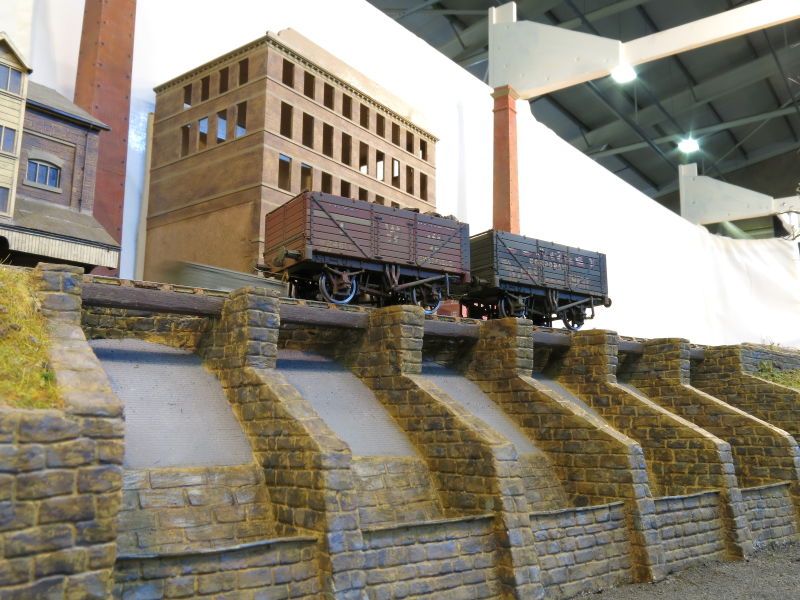Two reports on the evening from Stephen Duffell and Dave Knight.
“Kerrinhead” A P4 Scale layout by Gavin Clark .
At our November meeting, Gavin Clarke from Ludlow discussed the building of his layout Kerrinhead. This is a P4 layout and had its origins at the regular weekly meetings a local modelling group, that was originally for P4 aficionados but now includes OO, EM and 2mm folk. Gavin's railway room is housed in an attic room and a steep and narrow access dictated the size of baseboards which did not follow conventional rectangular shapes. Instead boards were curved and the edges followed natural landscape features such as walls to disguise the joins.
 The coal drops at Kerrinhead station.
The coal drops at Kerrinhead station.
There already existed a P4 layout running around the room and Kerrinhead was built as a branch line terminus. It is set in the Lancashire hills, based in features around Todmorden, and is a fictitious Lancashire and Yorkshire station in the period soon after the 1923 grouping. It features a single platform station with goods shed, coal drops and a small engine shed and turntable. It took 3 years from conception to its first show at Scalefour North in 2015. Gavin built the baseboards and was helped in building trackwork by the late John Bailey (who also built and engineered the turntable) and Geoff Taylor who provided buildings at one end of the layout. The large mills to the rear of the layout await completion.
Gavin brought along two of the baseboards to show constructional methods, together with the control panel. Much interest was shown in his methods of scribing walls and other landscape features, although not everyone felt they had the patience to model in this way. The control panel contained the lever frame (another John Bailey design) that is available from the Scalefour Society, and the layout is run using the NCE DCC system.
Stephen Duffell.
Gavin’s most enjoyable talk, supported by slides of the layout and 2 actual sections from it, delivered exactly what he’d promised – an insight into its origins, the inspiration behind it, its construction, the problems encountered and some of its main features.
What was obvious throughout was Gavin’s attention to detail, not only in replicating a prototypically accurate station layout but also the landscape in which it sits,the features within it and the architecture typical of the area in which the layout is based. Particularly pleasing is the absence of straight lines in the landscapingand its 3-dimensional qualities – both reflected in the buildings located within it and considerably enhancing the layout’s overall realism.
All of this, however, creates constructional problems which were obvious in the sections of layout he brought with him. These too had very few straight lines and resembled the pieces of a 3-dimensional jigsaw! A situation further compounded by the limitations on size imposed by a narrow right-angled staircase that has to be negotiated in order to remove the layout from its usual storage location before transportation to exhibitions. Determining the size and shape of baseboards and trying to match the joints between them with convenient “break points” in the landscape has been achieved with remarkable success. However, being such diverse shapes and sizes means that they can’t be self-supporting and have to be assembled and supported on a level “sub-baseboard” of trestle tables.
To get an insight into the quality of buildings, readers are best referred to the pictures that appear on the internet – type “Kerrinhead” in to Google. What isn’t obvious from these is that the majority of stonework featured often comprises stones individually applied or scribed into a modelling compound! And with the rubble stone walls in the landscaping this is generally done in-situ – way beyond my patience and ability!
The choice of P4 for trackwork etc. was barely referred to but consistent with the striving for prototypical accuracy demonstrated throughout the rest of the layout.
This was an inspirational evening, difficult to summarise but I would thoroughly recommend that if you see this layout featured at an exhibition you make the effort to go along and see it – you will not be disappointed!
David Knight.